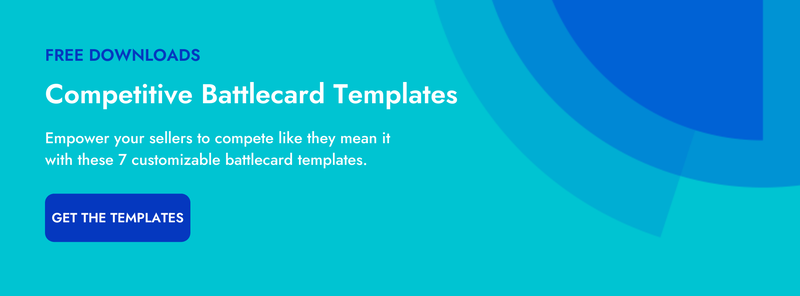Battlecards have historically lived in static PDFs delivered via email to sales reps’ computers. And by historically, I mean most battlecards today are static documents that are always out-of-date, hard to find, hard to measure, and thus nearly useless. Until now - dynamic battlecards integrated with a competitive intelligence platform allow you to deliver always up-to-date competitive information and sales guides (while also being able to measure their usage and impact on win rate).
But what sort of dynamic information can you integrate into your battlecard? And what if you could truly automate the population of competitive information to be referenced by sales? With the power to integrate automatically updating intel onto your battlecards, the question turns from how to integrate into what to integrate.
Here are 10 types of auto-updating intelligence to integrate into your dynamic battlecards.
1. Upcoming Events
Help your sales team know when and where they may run into your competitors by sharing their upcoming event activity. This will allow sales reps to prepare for conversations with prospects at those events or even gather more intel at competitor booths.

2. Recent News & Content
Alert your sales team to the latest news headlines and top content being promoted by your competitors. This will allow them to be knowledgeable about anything major that may come up in sales conversations.
3. Executive Twitter Feed
An executive’s Twitter feed - for example, the CEO’s account - can provide a deeper view into how a competitor operates and what they are promoting. This is a great addition to a dynamic battlecard, giving your sales reps more color on a competitor’s strategy.
4. Current Promotions & Discounts
A timely, critical piece of intelligence for a sales team is a competitor’s promotions and discounts currently running. Highlighting the latest web promotions or discounts being advertised is a great way to help reps tailor their pricing discussions.
5. Recent Reviews
Customer reviews are chock full of great competitive intelligence. Highlighting recent reviews - whether you showcase all of them or filter to those on key topics (say, customer service or integrations, any aspect of key importance in the sales process) - is a great way to arm your sales team with confidence and stories for calls. This also serves as guidance for which review sites to recommend to prospects.
6. Latest Pricing
Pricing is, of course, a key piece of intelligence for any sales battlecard. You may choose to curate what pricing information is shared with the team, but you can augment that with automatically sharing updates to the pricing page, or newly discovered pricing quotes and proposals. This intel - no matter how long or complex - is likely to get a lot of attention from your sales team.
7. Partnership Changes
A competitor’s partners can have a significant impact on a sale, whether it be by the suite of solutions provided or relationships established. Knowing about the latest partners being added - and those removed - is just as important, if not more so, as knowing product details and differences.
8. Customer Testimonials
Customer testimonials and case studies tell you a lot about a competitor - industries and use cases served, for example - but they also explicitly tell you which customers a competitor has. The latter can be helpful context to have if a sales rep is reaching out to a competitor’s customer, to tailor the conversation. And the former use case gives your sales team intel on a competitor’s strengths and focus areas.
9. Hiring Trends & Executive Changes
Hiring trends and executive team changes tell you a lot about a company’s direction. Highlighting where a competitor is investing in terms of personnel additions and leadership changes can provide a lot of insight for a sales rep’s understanding of a competitor’s standing in the market.

10. Field Intelligence
Some of the most valuable competitive intelligence you can capture is gathered in the field from marketers at events, sales reps on calls, or running into a former coworker who works for a competitor. This intelligence should be fed into your centralized competitive intelligence platform, and you can automatically surface the worthy updates in a battlecard tile dedicated to field intelligence. This can be a great way to share stories from the field and reinforce other key points from your battlecard content.
When it comes to incorporating auto-updated intel onto your sales battlecards, consider whether or not your sales team needs context and curation before intel is delivered to them. These example tiles do not require a lot of individual explanation and can provide immediate value to a sales rep viewing a battlecard. Be sure to couple this with more contextualized guidance around a competitor’s products and services, differentiation, questions to ask, and more.
Incorporating dynamic tiles with new intelligence that is automatically updated helps show your sales team that your battlecards are living and breathing, and the go-to resource for the latest competitive information. When battlecards are constantly being updated with the latest intel, even the most seasoned reps, who seemingly know their competitors inside and out, will continue to come back to these key sales enablement staples.

Related Blog Posts
Popular Posts
-
 The 8 Free Market Research Tools and Resources You Need to Know
The 8 Free Market Research Tools and Resources You Need to Know
-
 How to Create a Competitive Matrix (Step-by-Step Guide With Examples + Free Templates)
How to Create a Competitive Matrix (Step-by-Step Guide With Examples + Free Templates)
-
 6 Competitive Advantage Examples From the Real World
6 Competitive Advantage Examples From the Real World
-
 24 Questions to Consider for Your Next SWOT Analysis
24 Questions to Consider for Your Next SWOT Analysis
-
 How to Measure Product Launch Success: 12 KPIs You Should Be Tracking
How to Measure Product Launch Success: 12 KPIs You Should Be Tracking





